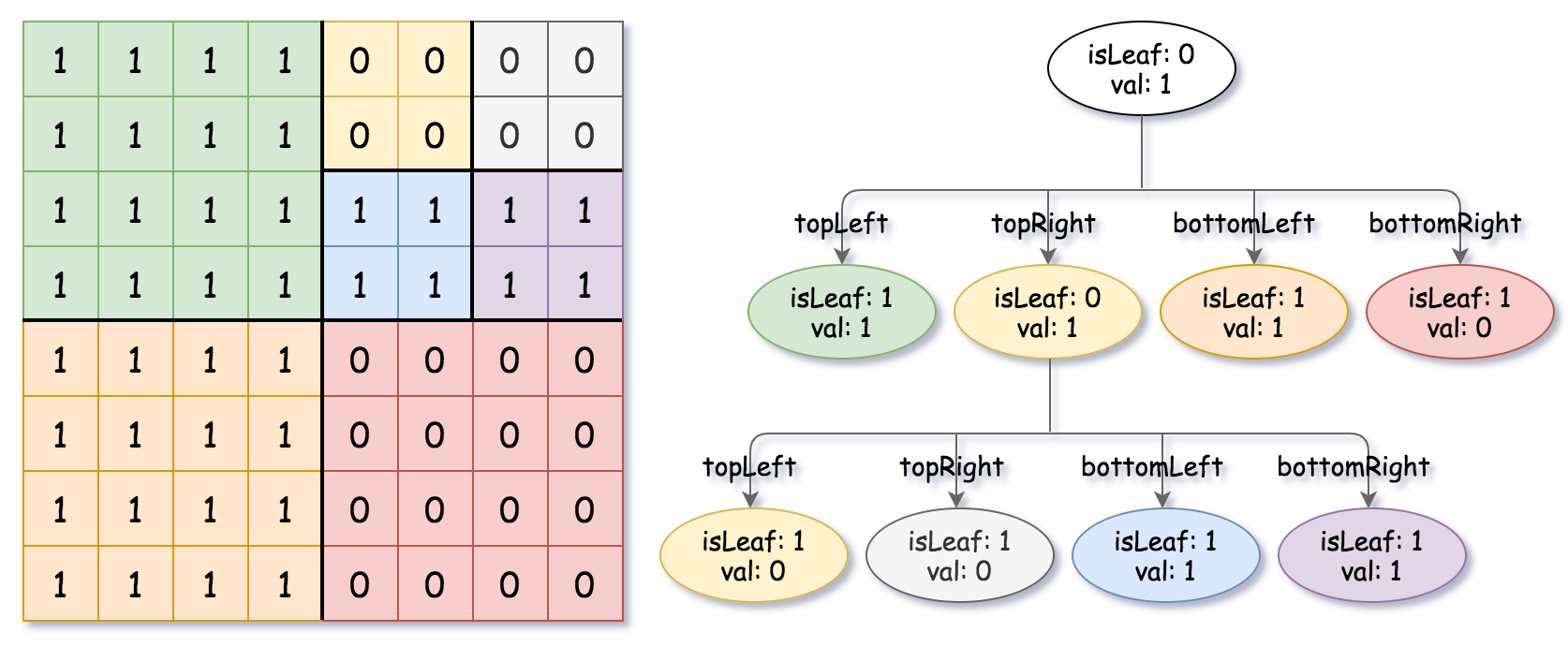1. 题目描述
https://leetcode-cn.com/problems/construct-quad-tree/
给你一个 矩阵
grid ,矩阵由若干 和
组成。请你用四叉树表示该矩阵
grid 。
你需要返回能表示矩阵的 四叉树 的根结点。
注意,当 isLeaf 为 False 时,你可以把 True 或者 False 赋值给节点,两种值都会被判题机制 接受 。
四叉树数据结构中,每个内部节点只有四个子节点。此外,每个节点都有两个属性:
val:储存叶子结点所代表的区域的值。对应
True,对应
False;isLeaf: 当这个节点是一个叶子结点时为True,如果它有个子节点则为
False。
我们可以按以下步骤为二维区域构建四叉树:class Node {public boolean val;public boolean isLeaf;public Node topLeft;public Node topRight;public Node bottomLeft;public Node bottomRight;}
- 如果当前网格的值相同(即,全为
或者全为
),将
isLeaf设为True,将val设为网格相应的值,并将四个子节点都设为Null然后停止。 - 如果当前网格的值不同,将
isLeaf设为False, 将val设为任意值,然后如下图所示,将当前网格划分为四个子网格。 - 使用适当的子网格递归每个子节点。

四叉树格式:
输出为使用层序遍历后四叉树的序列化形式,其中 null 表示路径终止符,其下面不存在节点。
它与二叉树的序列化非常相似。唯一的区别是节点以列表形式表示 。
如果 isLeaf 或者 val 的值为 True ,则表示它在列表 中的值为
;如果
isLeaf 或者 val 的值为 False ,则表示值为 。
示例 1:
输入:grid = [[0,1],[1,0]]
输出:[[0,1],[1,0],[1,1],[1,1],[1,0]]
解释:请注意,在下面四叉树的图示中,0 表示 false,1 表示 True 。
示例 2:
输入:grid = [[1,1,1,1,0,0,0,0],[1,1,1,1,0,0,0,0],[1,1,1,1,1,1,1,1],[1,1,1,1,1,1,1,1],[1,1,1,1,0,0,0,0],[1,1,1,1,0,0,0,0],[1,1,1,1,0,0,0,0],[1,1,1,1,0,0,0,0]]
输出:[[0,1],[1,1],[0,1],[1,1],[1,0],null,null,null,null,[1,0],[1,0],[1,1],[1,1]]
解释:网格中的所有值都不相同。我们将网格划分为四个子网格。
topLeft,bottomLeft 和 bottomRight 均具有相同的值。
topRight 具有不同的值,因此我们将其再分为 4 个子网格,这样每个子网格都具有相同的值。
示例 3:
输入:grid = [[1,1],[1,1]]
输出:[[1,1]]
示例 4:
输入:grid = [[0]]
输出:[[1,0]]
示例 5:
输入:grid = [[1,1,0,0],[1,1,0,0],[0,0,1,1],[0,0,1,1]]
输出:[[0,1],[1,1],[1,0],[1,0],[1,1]]
提示:
其中
2. 题解
2022-04-29 AC, 初看起来完全懵逼, 不知道这个node节点到底怎么个输出法, 判断是否是子节点还行, 就是遍历一遍
看了题解瞬间醍醐灌顶, 一个深搜, 主要就是生成新的四块区域, 这也是调试时间最长的地方 ```php <?php /**- Created by PhpStorm
- User: jtahstu
- Time: 2022/4/29 17:49
- Des: 427. 建立四叉树
- https://leetcode-cn.com/problems/construct-quad-tree/
- 题目过长 */
//Definition for a QuadTree node. class Node { public $val = null; public $isLeaf = null; public $topLeft = null; public $topRight = null; public $bottomLeft = null; public $bottomRight = null;
function __construct($val, $isLeaf)
{
$this->val = $val;
$this->isLeaf = $isLeaf;
$this->topLeft = null;
$this->topRight = null;
$this->bottomLeft = null;
$this->bottomRight = null;
echo "$isLeaf, $val\n";
}
}
class Solution { public $grid = [];
/**
* @param Integer[][] $grid
* @return Node
*/
function construct($grid)
{
$this->grid = $grid;
$n = count($grid);
return $this->dfs(0, 0, $n - 1, $n - 1);
}
function dfs($a, $b, $c, $d)
{
$is_leaf = true;
$val = $this->grid[$a][$b];
if ($a == $c && $b == $d) {
return new Node($val, $is_leaf);
}
//判断矩形里的值是否都相同
for ($i = $a; $i <= $c; $i++) {
for ($j = $b; $j <= $d; $j++) {
if ($this->grid[$i][$j] != $val) {
$is_leaf = false;
break 2;
}
}
}
//是子节点就不用再递归了
if ($is_leaf) {
return new Node($val, $is_leaf);
}
$node = new Node($val, $is_leaf);
$g = ($a + $c + 1) / 2; //x轴中点靠右
$k = ($b + $d + 1) / 2; //y轴中点靠右
$node->topLeft = $this->dfs($a, $b, $g - 1, $k - 1);
$node->topRight = $this->dfs($a, $k, $g - 1, $d);
$node->bottomLeft = $this->dfs($g, $b, $c, $k - 1);
$node->bottomRight = $this->dfs($g, $k, $c, $d);
return $node;
}
}
(new Solution())->construct([[1, 1, 1, 1, 0, 0, 0, 0], [1, 1, 1, 1, 0, 0, 0, 0], [1, 1, 1, 1, 1, 1, 1, 1], [1, 1, 1, 1, 1, 1, 1, 1], [1, 1, 1, 1, 0, 0, 0, 0], [1, 1, 1, 1, 0, 0, 0, 0], [1, 1, 1, 1, 0, 0, 0, 0], [1, 1, 1, 1, 0, 0, 0, 0]]); //(new Solution())->construct([[0, 1], [1, 0]]);
/**
- 执行用时:28 ms, 在所有 PHP 提交中击败了100.00%的用户
- 内存消耗:19.7 MB, 在所有 PHP 提交中击败了100.00%的用户
- 通过测试用例:22 / 22 */
/**
- 使用前缀和优化「判断全 0 和全 1」的操作
- 个人感觉速度也没快, 反而引入了额外的空间, 不如暴力^_^
- class Solution {
static int[][] sum = new int[70][70];
int[][] g;
public Node construct(int[][] grid) {
} Node dfs(int a, int b, int c, int d) {g = grid; int n = grid.length; for (int i = 1; i <= n; i++) { for (int j = 1; j <= n; j++) { sum[i][j] = sum[i - 1][j] + sum[i][j - 1] - sum[i - 1][j - 1] + g[i - 1][j - 1]; } } return dfs(0, 0, n - 1, n - 1);
} } */ ```int cur = sum[c + 1][d + 1] - sum[a][d + 1] - sum[c + 1][b] + sum[a][b]; int dx = c - a + 1, dy = d - b + 1, tot = dx * dy; if (cur == 0 || cur == tot) return new Node(g[a][b] == 1, true); Node root = new Node(g[a][b] == 1, false); root.topLeft = dfs(a, b, a + dx / 2 - 1, b + dy / 2 - 1); root.topRight = dfs(a, b + dy / 2, a + dx / 2 - 1, d); root.bottomLeft = dfs(a + dx / 2, b, c, b + dy / 2 - 1); root.bottomRight = dfs(a + dx / 2, b + dy / 2, c, d); return root;

